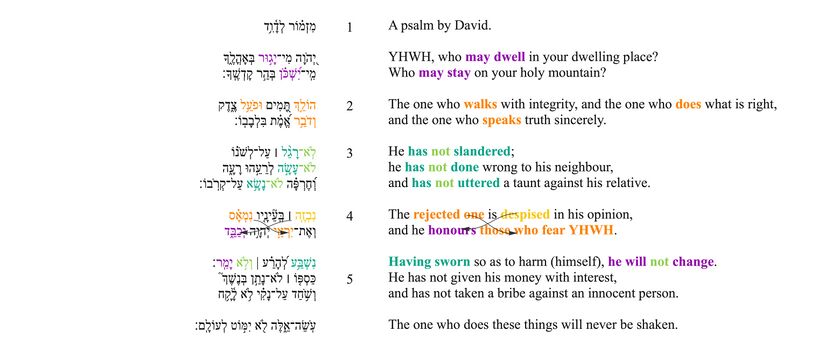Psalm 15 Poetics
Poetic Structure
Top Poetic Features
2. From Simple to Complex
Feature
Verses 1, 2 and 3 all have only one verbal form each (repeated two or three times). In verse 4, verbal forms begin to be combined together.
The most complex syntax is in the chiasm of v. 4ab, in which the man despises the one rejected (by God) and honours those who fear YHWH. The 'rejected one' and those who 'fear' YHWH are both participles, as well as the 'despising' that the man does. Determining the subject and the predicate (the rejected one is despised, or the despised one is rejected) is not straightforward.
Effect
Whereas the syntax and semantics have been almost childishly clear before v. 4, the complex syntax of v. 4 mirrors the complexity of the meaning: it is not easy to determine who should be despised (treated as an outsider) and who should be honoured, but the one who may dwell with YHWH will be able to judge rightly.
3. Not Jumping to Conclusions
Feature
"'Speaking truth in his heart' may mean either that his inmost thought treasures honesty or that he speaks accurately and sincerely. Also, in v. 3 herpa lo nasa al qerobo means either 'he does not vilify his neighbor' or 'he does not bear reproach on account of his neighbor'; and in v. 4 beenayw can modify either 'the vile' or 'the one to be rejected'... Laqach in v. 5 can refer to taking a bribe out of one's pocket or to taking a bribe and putting it in one's pocket. This piling up of ambiguities suggests that all are intentional; in other words, they are double entendres."[1]
Each verse of requirements has at least one ambiguity that could be read in a very unattractive light.
Effect
Integrity comes out in how you respond to situations that could be interpreted multiple ways. Ambiguity is a fact of life, and the person who has integrity is trustworthy even within ambiguity. He will not jump to conclusions ("but this actually says...") but will interpret events appropriately, within their context.
Line Divisions
Line Length
Repeated Roots
References
- ↑ Waltke 2010:294.





